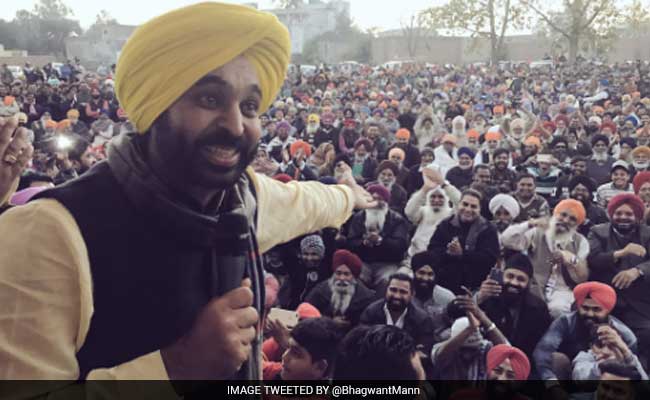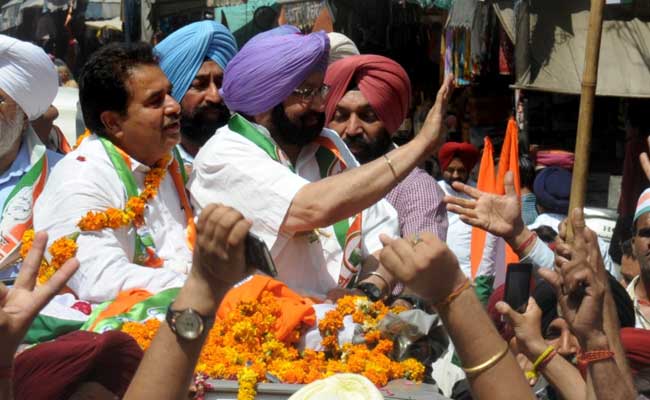And you would lose, big time, for the calm is deceptive; beneath it seethes churn. A churn that could perhaps send the Akalis into political oblivion and may even completely overthrow the current two-party political order. If the villages of Malwa, the southern part of Punjab, with its 63 seats (the state has a total of 117) were the only places voting, the Aam Aadmi Party's clarion call "Kejriwal, Kejriwal, saara Punjab tere naal (Kejriwal, all of Punjab is with you)", would be resounding. In an area where they surprised everyone in 2014 by winning four parliamentary seats, including Congress leader Captain Amarinder Singh's pocket borough of Patiala, the leher (wave) seems to have spread.

AAP's biggest crowd magnet in Punjab, Bhagwant Mann, one of the country's most popular stand-up comedians - is widely seen as the party's chief ministerial candidate
Jobs is a big deal, especially for the youth, who are amongst the key demographics for the AAP. Well educated and unwilling to till the land they face poor prospects of work. Their disillusionment is one of the reasons that drugs have devastated the youth in villages where elders say they can't tell you how many do drugs, but can count the handful that don't. As they say this, you can feel their pain and anger. And one of AAP's efforts is to use the youth to reach their parents, especially mothers through their sons, trying to break the tradition of women in villages following their men folk.
There is also pent-up anger over the fact that the Badal government has failed to catch the culprits who tore pages out of the Guru Granth Sahib, in October 2015, which culminated in the shooting in Bargari.

Punjab Congress' chief ministerial candidate Captain Amarinder Singh is contesting from Patiala and Lambi
The Congress should have been the exploiter of this as the traditional rival to Akalis, but has somehow seemingly missed the opportunity in rural Malwa. The feeling seems to be that if we seek change, why change to something we have seen before. Let's go for broke and choose the outsider. The Congress can't be completely discounted. It has a strong base that in 2014 fell, but only to 33% (from 40%), here. And that's why they can't be written off, especially in the more urban constituencies and urban portions of other constituencies (the party is stronger in urban and Hindu areas than rural and Sikh-dominated ones). The Congress also has considerable support amongst older voters, and could catch disenchanted Akalis unwilling to go with the Haryanvi Kejriwal. Given all that Congress is running second in Malwa, with the Akalis a poor third.
AAP, meanwhile, is looking to capture as many as two thirds or more of the seats here. If their jaloos (procession) through Ludhiana on the last day of campaigning was anything to go by, Malwa may leave them a bit more than a baker's dozen short of power.

Parkash Singh Badal (R), Chief Minister of Punjab, faces one of the toughest battles of his political career
It seems strange to talk of Punjab without talking about the chances of an Akali third term, but almost universally, people see this as a two-party race, between the jhaadu and the haath. Even Akali supporters seem to have resigned themselves to a drubbing. At Parkash Singh's 21st-century red brick fortress in Badal village on the day prior to polling, there is an emptiness; no crowds of supporters, just silence.
As the sun breaks through late in the afternoon of voting day, does it portend an AAP victory? Of the three scenarios: AAP victory, a hung house, or a Congress win, the first looks more probable, the second possible, and the third, an outside chance. Of course, in 2012, everyone was predicting a Congress victory, but the Badals pulled the rabbit out of the bag. They are unlikely do it again.
(Ishwari Bajpai is Senior Advisor at NDTV)
Disclaimer: The opinions expressed within this article are the personal opinions of the author. The facts and opinions appearing in the article do not reflect the views of NDTV and NDTV does not assume any responsibility or liability for the same.


